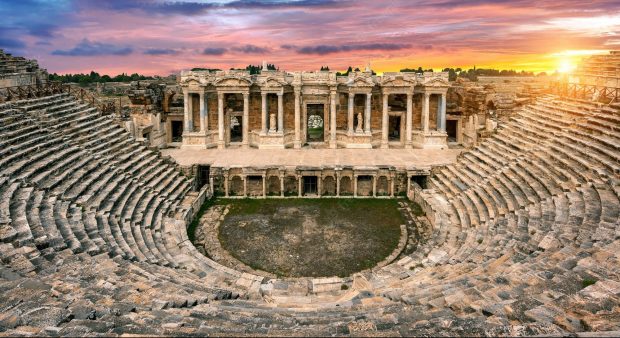History of the city of Hierapolis
Based on the name of the city, the ancient city of Hierapolis was founded in the 2nd century BC by Eumenes II, one of the kings of Pergamon. It is estimated that it got its name from Hiera, Queen of the Amazons, the wife of Telephos, the hero of Pergamon. The word “Hiera” means “holy” in the Hellenic language. It was stated by archeology researchers that there was life in the city before the 2nd century BC, and its establishment as a city and taking its name took place on this date. This date coincides with the Hellenistic period. With the Apomia peace treaty signed after the Magnesia War between Antiochus III and Rome in 188 BC, Hierapolis came under the rule of Pergamon. In 133 BC, it was included in the province of Asia.
Between the 2nd century BC and the 1st century AD, the city showed extraordinary economic development with the production and export of textiles, wool and purpur (the color of Judas tree obtained from insects). The city was completely destroyed by an earthquake in 17 AD during the early Roman Empire. It was restored with a new plan. In an inscription found, Roman Emperor Nero provided economic assistance for the reconstruction of the city. In 86 AD, the city was visited by the Roman Emperor Domitianus and the Frontinus (Domitianus) Gate was built in his honor. The Temple of Apollo and the Gymnasium (School) were built by the Flavian dynasty, another Roman Empire dynasty.
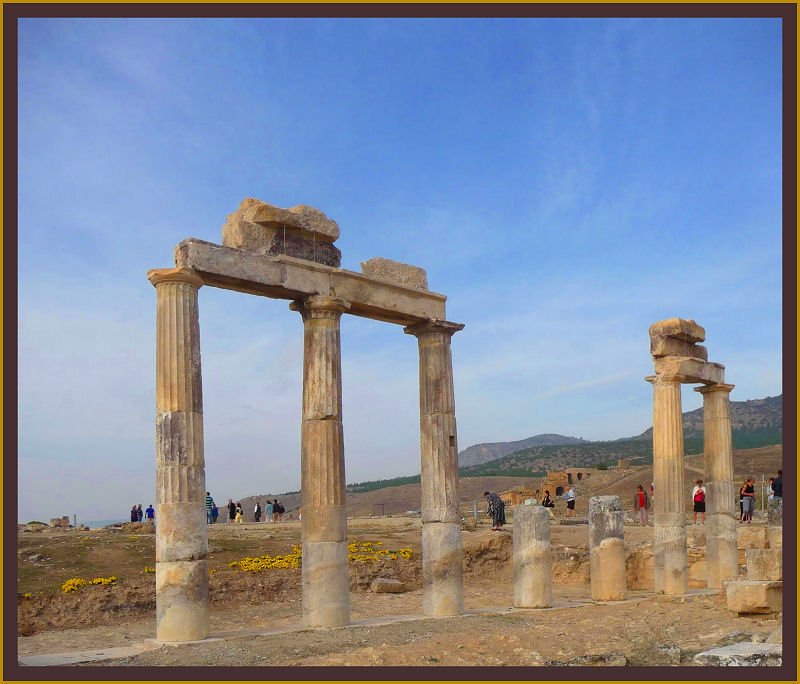


Significance of Hierapolis for the Roman Empire
The inscriptions obtained during the excavations and Roman years show that the city was visited by Emperor Hadrian in 130 AD, by Emperor Caracalla in AD 215, and by Emperor Valens in AD 370. Between 138-144 AD, Bishop Papias and Apollinarius made efforts to spread Christianity in Hierapolis. Again at this time, many Jews settled in Hierapolis. During the reign of Emperor Septimius Severus in 193-211 AD, the city showed an economic development. The notables of the city organize various games and international competitions are held in the name of Apollo, the chief god of Hierapolis. During the reign of Emperor Elagabal in 218-222 AD, the city was given the title of “Neokoros” (a title given to the Roman Empire, meaning protector). Deductions are made in the taxes it has to pay to Rome.
With the earthquake that occurred in the second half of the 4th century AD, the city was again destroyed and most of the buildings were damaged. During the reign of Theodosius II in AD 379-395, city walls with two gates in the north and south were built. After another earthquake in the second half of the 7th century AD, the city became uninhabitable. Hierapolis gains a unique appearance with Pamukkale Travertines, which are famous for its hot springs in Denizli. The ancient city was included in the UNESCO World Heritage List on December 9, 1988.
Religious features of Hierapolis
Hierapolis became a very important religious center during the Roman and Byzantine periods. This is because; It is the murder of St. Philippus, one of the 12 apostles of Jesus, who came to the city to spread Christianity in 80 AD. St. Philippus is an important person for Christians. After his death, the city became one of the pilgrimage centers of Christians. When they came to make pilgrimage, men could enter the city after cutting their hair and beards and perform their pilgrimage. They made their pilgrimage in the funerary church built next to St. Philippus’ tomb. The church was also used as a religious and spiritual treatment center. Today, it is celebrated with the name “St. Philippus Feast” and a ritual is held.
Buildings of the city of Hierapolis
Northern Byzantine gate of Hierapolis
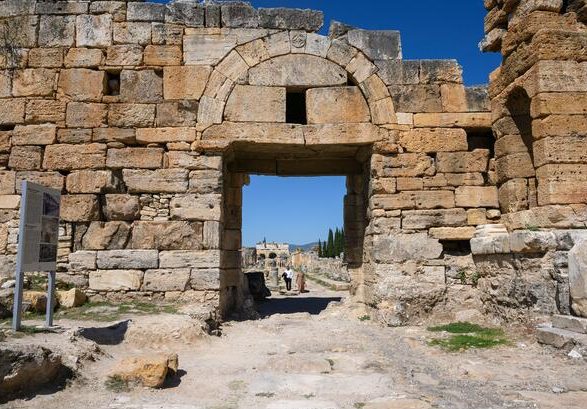


The northern gate, which was included in the fortification system in the city of Hierapolis, was built at the end of the 9th century AD. The gate is symmetrical to the South gate. On both sides of the gate are towers supporting it. Christian symbols of the period were also engraved on it.
Frontinus gate
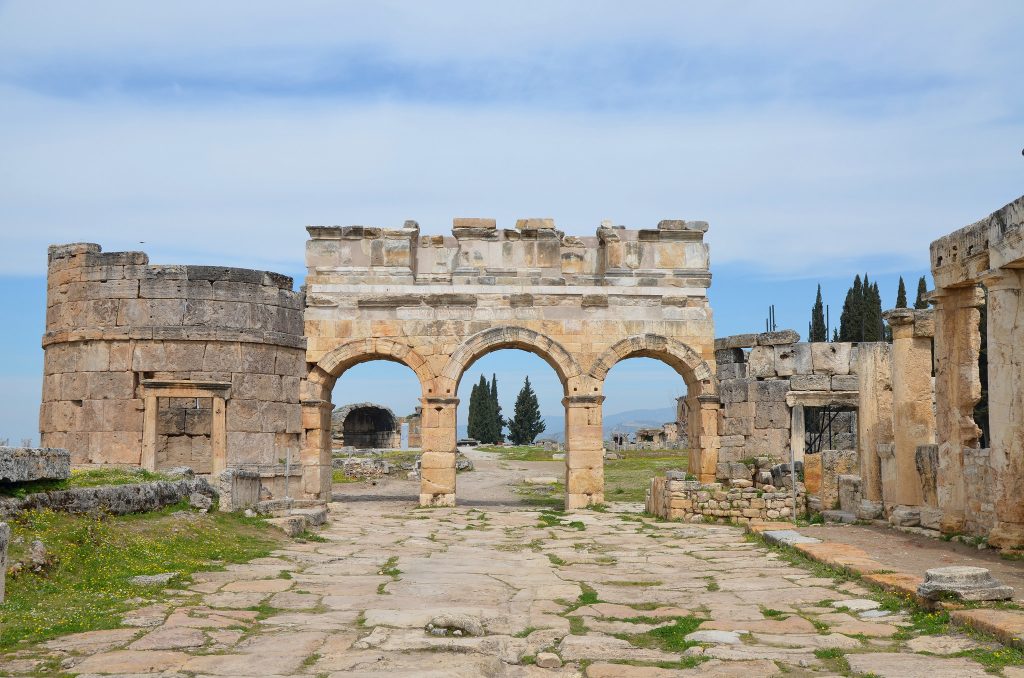


In an inscription found, it is learned that the door was dedicated to Emperor Domitianus. The building has three arches. The gate was built by Sextus Julius Frontinus, the city’s Proconsul. For this reason, the gate is also called the Frontinus gate. There are round towers on both sides of the gate.
Frontinus Street
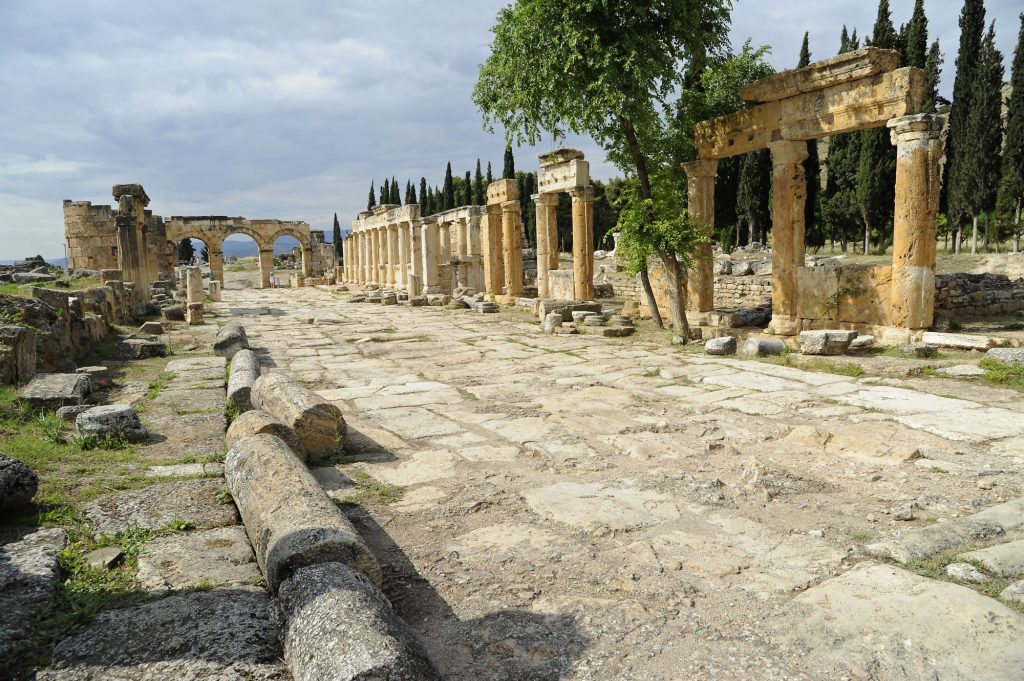


It is a 14 m wide and 170 m long street, which is thought to have been built together with the door due to its architectural features. It forms the main street of the city. In the middle of the street there is a canal for sewage water.
Great bath
It is a building dating from the 2nd century AD. It is a typical Roman bath. First, it is a large courtyard at the entrance, a closed rectangular area with large halls on both sides. Bath; It consists of a Roman bath, a Gymnasium and a library. Today, it is used as the Hierapolis Archeology Museum.
Water channels and Nymphaeum (water reservoir)
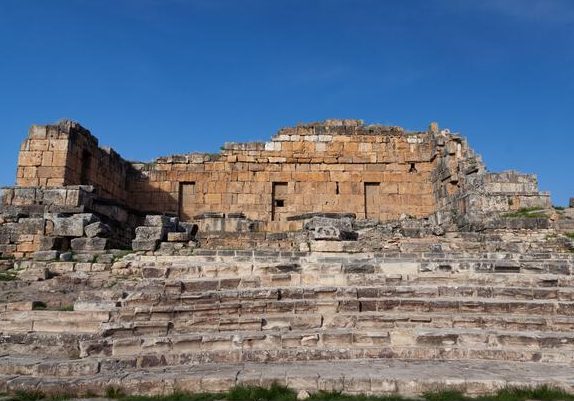


Two aqueducts consisting of canals built on the surrounding hills provide drinking water to the city. One of them is between Pamukkale and Karahayıt in the north, and the other is in the direction of Güzelpınar in the east. These channels converge in a filter chamber built on the hill to the east of the city. The water coming out of here reaches the streets of the city with terracotta pipes and then to the houses with smaller pipes.
the Apollon Temple
It was built on Plutonion, which was used as an ancient and religious cave belonging to the Hellenistic period. Although the remains of the upper structure in the Temple of Apollo do not go back to the 3rd century AD, the foundations date back to the Late Hellenistic period. Apollo is the most blessed and popular god in Hierapolis.
Theatre
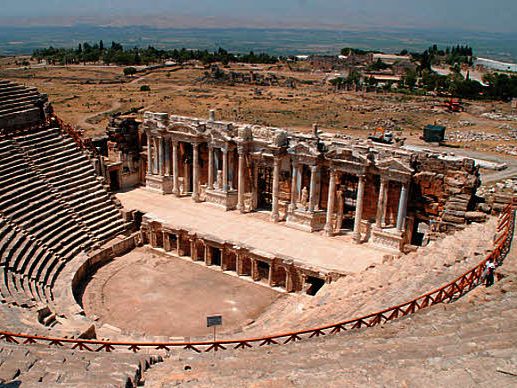


It is a large building leaning on the hillside in the type of Greek theatre. The large structure is built on four islands. The steep cavea is divided into two parts from the diazoma (the part where the audience sits). The theater was built in the 2nd century AD and was restored in the 3rd century AD. The audience capacity is approximately 10,000 people. There are 50 rows of seats. Mythological elements were processed on the stage.
St. Philippus’ tomb
He is one of the 12 apostles of Jesus. He came to Hierapolis to spread Christianity in 80 AD. He was crucified here. After Christianity was accepted as the official religion in the 4th century AD, St. Philippus was given the title of “Saint” and a church was built in his name.
St. Philippus Martyrion
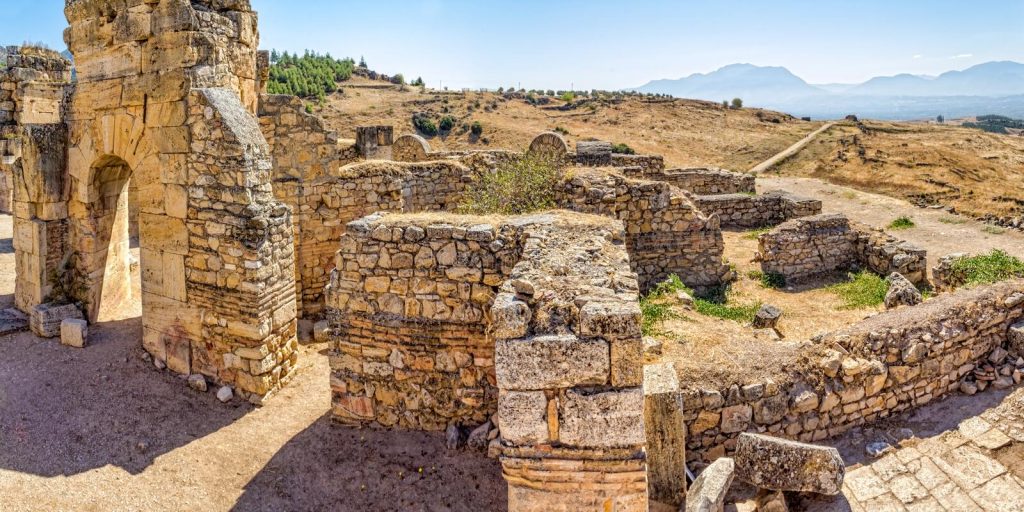


The church built in the name of St. Philippus, who was accepted as a martyr, is called “Martyrion”. Martyrion has eight facades. The building is located on a high hill outside the city. It has 32 rooms. The octagonal section with a diameter of about 20 m is covered with a lead-coated dome. There are small chapels for praying in the building. The church was also used as a religious and spiritual treatment center.
Southern Byzantine gate
It was built in the 4th century AD. It was built with travertine blocks and spolia material containing marble. As in the northern gate, there are symmetrical and rectangular towers on both sides. The place where the gate is located is lower than the northern gate.
Source: Francesco D’ADRIAN Hierapolis Archeology Guide
